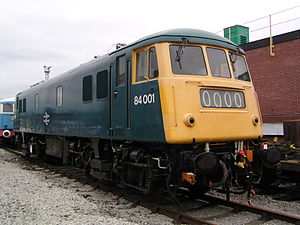British Rail Class 84

Preserved locomotive 84001 on display at Crewe Works open day on 11 September 2005
|
|||||||||||||||||||||||||||||||||||||||||||
|
|||||||||||||||||||||||||||||||||||||||||||
|
|||||||||||||||||||||||||||||||||||||||||||
|
|||||||||||||||||||||||||||||||||||||||||||
|
|||||||||||||||||||||||||||||||||||||||||||
| Type and origin | |
|---|---|
| Power type | Electric |
| Builder | North British Locomotive Company |
| Order number | L91 |
| Build date | 1960–1961 |
| Total produced | 10 |
| Specifications | |
|---|---|
| Configuration: |
|
| • Whyte | Bo-Bo |
| • AAR | B-B |
| • UIC | Bo'Bo' |
| Gauge | 4 ft 8 1⁄2 in (1,435 mm) standard gauge |
| Wheel diameter | 4 ft 0 in (1.219 m) |
| Wheelbase | 39 ft 6 in (12.04 m) |
| Length: |
|
| • Over beams | 53 ft 6 1⁄2 in (16.32 m) |
| Width | 8 ft 8 1⁄4 in (2.648 m) |
| Height: |
|
| • Pantograph | 13 ft 0 9⁄16 in (3.977 m) |
| • Body height | 12 ft 4 1⁄4 in (3.766 m) |
| Loco weight | 76.60 long tons (77.83 t; 85.79 short tons) |
| Electric system(s) | 25 kV AC Catenary |
| Current source | Pantograph |
| Traction motors | 4 × GEC WT501 |
| Gear ratio | 25:74 |
| Train heating | Electric Train Heating |
| Train brakes | Vacuum; Dual from 1972 |
| Performance figures | |
|---|---|
| Maximum speed | 100 mph (160 km/h) |
| Power output: |
|
| • 1 hour | 4 × 890 hp (660 kW) |
| • Continuous | 4 × 750 hp (560 kW) |
| Tractive effort | 50,000 lbf (220 kN) |
| Brakeforce | 65.5 long tons-force (653 kN) |
| Career | |
|---|---|
| Operators | British Rail |
| Numbers | E3036–E3045; later 84001–84010 |
| Axle load class | Route availability 6 |
| Retired | 1979–1980 |
| Disposition | One preserved, remainder scrapped |
The British Rail Class 84 was a 25 kV AC electric locomotive that operated on the West Coast Main Line of the London Midland Region.
As part of the modernization of the West Coast Main Line, which included electrification, 100 locomotives of five types were acquired from different manufacturers. Ten Class AL4 locomotives numbered E3036 - E3045 were built in 1960 to a design by GEC by the North British Locomotive Company in Springburn, Glasgow.
Locomotive E3040 worked the inaugural AC electric-hauled train from Manchester Piccadilly to Crewe on 12 September 1961.
The locomotives always worked on power provided by overhead catenary energized at 25,000 V AC. However, the main transformer, normally operated with the four windings in series, could be operated at 6250V AC with the transformer windings in parallel. This voltage was initially to be used where limited clearances gave concern over use of the higher voltage.
Problems with the mercury-arc rectifiers plagued this class and in 1962 E3036 was returned to GEC, the builder of the electrical equipment, in an attempt to find a solution.
Within a year, all ten were out of service for repair. The problems persisted and in 1967 they were once more placed into storage, using the former steam shed at Bury, along with Class AL3. During this time E3043 went to Rugby Testing Centre for trials.
The persistent problems could have been the end of the ten locomotives of Class 84, but the extension of the West Coast Main Line electrification to Glasgow meant that more electric locomotives would be needed. It was therefore decided that the stored Class AL3 and AL4 locomotives would be repaired, which was conducted at Doncaster, and returned to service, with a lower number of Class 87 being built.
...
Wikipedia
